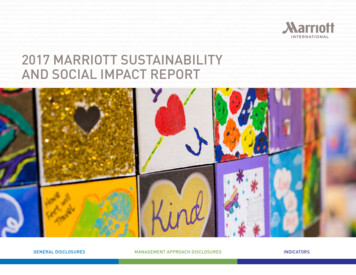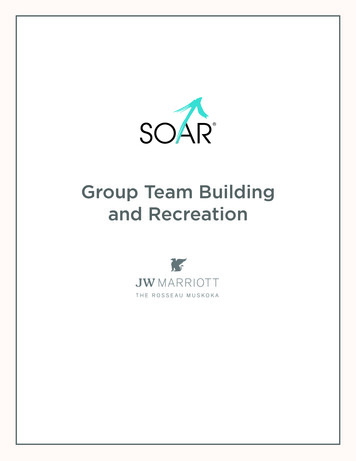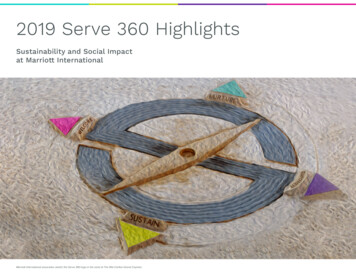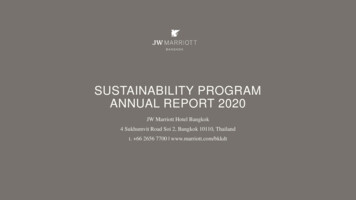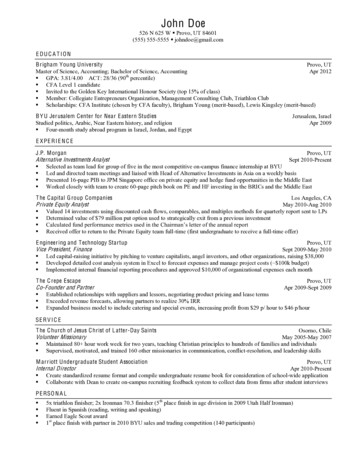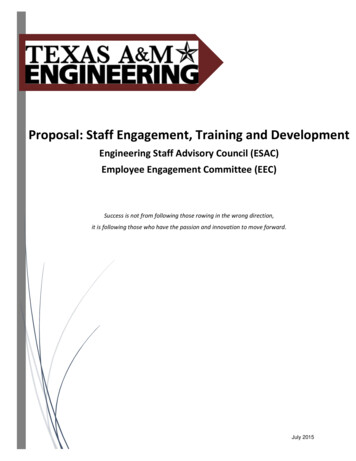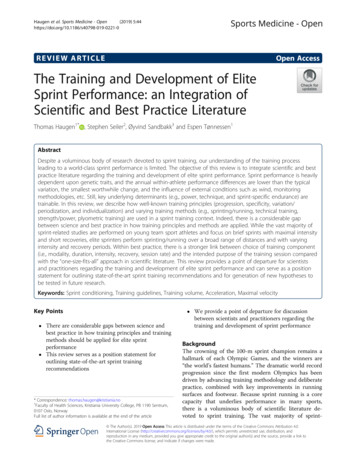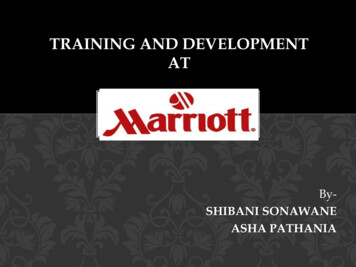
Transcription
TRAINING AND DEVELOPMENTATBySHIBANI SONAWANEASHA PATHANIA
Industry- Hospitality, Tourism Founded- Washington , D.C., U.S,(May15,1927) Headquarters- Bethesda , Maryland ,U.S Key people- J.W. MARRIOTT Jr.(Executive chairman) Arne Sorenson (CEO & President) Products- Hotels, Resorts Revenue – US 13.3 billion(2011) Employees- over 160000(2011) MARRIOTT is A leading lodging company with morethan 3,700 lodging properties in 73 countries andterritories.
MARRIOTT INDIA Marriott India is the Indiandivision of the MarriottInternational hotel chain. It wasestablished in 1998 . It has hotels in Mumbai, Goa,Hyderabad, Pune, Gurgaon,Ahmedabad ,Chennai andBanglore.
NEW HIRE ORIENTATION PROGRAMThe program starts with a new hire orientation programfor all employees to ensure new staff have the skillsneeded to perform effectively. The purpose of theprogram is to introduce new employees to the Marriottculture, brand, and their specific hotel/region.INTERNATIONAL HOURLY TRAININGMarriott claims to provide 15 minutes to training eachday to each hourly employee. The training addresses theessential skill and knowledge areas, such as culinary,rooms operation, purchasing, that are essential foremployees to master in order to do their jobs.
GATEWAYSThe Gateways program is for hourly non-managementemployees. It is designed to train discipline-specific skillsnecessary to individual positions. Participating disciplinesare: finance, HR, IT, loss prevention, PR and sales.CORE MANAGEMENT TRAININGMarriot managers participate in over 20 differentmanagement training programs. Courses are taught bycertified trainers, professional experts, and property basedmanagement. Other courses are self-directed, includinginternet-based learning. Classes generally have 20-25participants and include extensive group interaction,hands-on activities, pre and post-test evaluation, andaction planning.
GET ON BOARDThis learning experience is designed to introduce newmanagers hired both externally and internally toInternational Lodging. Through a variety of mediums, themanager "new to Marriott International" experiences andlearns Marriott's culture, policies and procedures forInternational Lodging while building the necessaryrelationships.ASHRIDGE VIRTUAL LEARNING RESOURCECENTRECommitment to associate development requires offeringemployees the opportunity to learn at their own pacethrough access to the Virtual Learning Resource Centre.
FACILITATOR LEAD PROGRAMS & OFFERINGSThe programs are categorized into three levels and correlatewith Marriott International’s Core Competencies(Leadership, Managing Execution, Building Relationships,Generating Talent and Organizational Capacity, Learningand Applying Personal Expertise, and Business/Functionalresults.)ADDITIONAL MARRIOTT MANAGEMENT TRAININGPROPERTY STRATEGIC PLANNING IMPLEMENTATIONThis two-day program is conducted 30 days prior to a newMarriott International hotel opening, and is designed for thehotel Leadership Team .
COURTYARD BY MARRIOTT INTERNATIONAL UNIVERSITYThis program is an international only Marriott training program offered toCourtyard by Marriott brand General Managers and Assistant Managers. Itis designed to focus on understanding the brand's positioning, product andservice standards, pricing strategies, effective food and beverage, andcreating hotel-specific action plans to achieve goals.TRAINING ON-PROPERTY PROGRAMSA workshop is created for hotel managers facilitating Marriott’s In theBeginning, Passports to Success, or other on property training programsfor hourly associates.EFFECTIVE TRAINING SKILLSBoth workshop and certification process which focuses on co-facilitationtechniques, stages of experiential learning, measurement, and betterunderstanding of learning styles.
THANK YOU
CORE MANAGEMENT TRAINING Marriot managers participate in over 20 different management training programs. Courses are taught by certified trainers, professional experts, and property based management. Other courses are self-directed, including internet-based learning. Classes generally have 20-25 participants and include extensive group interaction,
